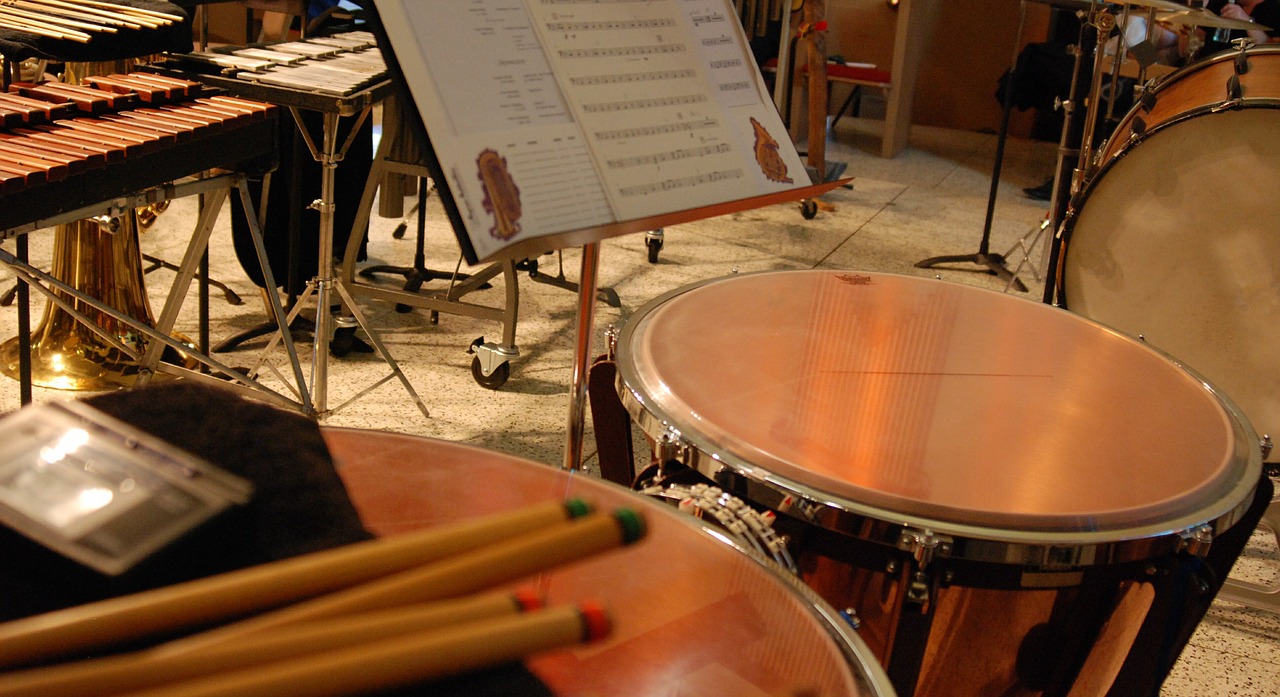15 Great Facts About The Timpani

They are among the largest, heaviest, and most challenging musical instruments on the planet. They have a place both in classical orchestras and rock’n’roll ensembles. They are versatile and their sound is energetic, echoing almost a thunder.
Timpani, or kettledrums, are an essential part of any classical orchestra. They are large semi-spherical drums made of two main components: a head or membrane, and a bowl.
To produce a sound, timpanists strike the head with a mallet. To produce the pitch required, the musician has to quickly change the tuning, usually through the use of a pedal.
Each timpano has a range of a perfect fifth, with a starting note depending on its size. Kettledrums are quite hard to play and for this reason, they are not a very popular option for young percussionists.
The singular for one of these drums is a timpano, the plural is timpani.
The video below shows the power and effect that the timpani can have:
Contents
- 1. They were military drums
- 2. The player can change their pitch
- 3. Timpanists have a high-paid job
- 4. They are very expensive instruments
- 5. They are very heavy instruments
- 6. The Moon of Pejeng
- 7. Timpani are traditionally made of copper
- 8. Timpani comes from a Latin word
- 9. There are many different types of timpani
- 10. Their role in contemporary music
- 11. Their dynamic range is impressive
- 12. Different mallet grips
- 13. They require sensitivity over power
- 14. They are fun to play
- 15. They are pitched percussion instruments
- Summary
1. They were military drums
Initially, timpani were employed as military drums.
Their use dates back to the 13th century when Crusaders and Saracens brought similar Arabian naqqara to Europe. These percussive instruments were way smaller in diameter (about 8 inches). They were the protagonists of military ceremonies throughout Europe until the 16th century.
From around 1400, a larger version of these drums evolved in France, becoming the direct ancestor of the modern timpani. From the 16th century, these military drums were often mounted on horses.
2. The player can change their pitch
Modern timpani can be tuned quickly through a movable foot pedal.
The challenge, however, is to tune them while the orchestra, with its gigantic sound, is playing. This is a hard task for two reasons: the player must have a perfect ear to keep their instrument in key with the rest of the ensemble; they must also keep their ears very close to the timpani to be able to hear what pitch they are playing.
Chain timpani, on the other hand, don’t have pedals. The tension of the head is controlled by a roller chain, making the tuning process even harder.
3. Timpanists have a high-paid job
The scarcity of professional timpani players makes this role one of the highest-paying in the whole music industry.
There are few timpani players for two main reasons: the difficulty of the instrument and the pressure deriving from having that role in an orchestra.
Playing timpani is hard, as a player needs a perfect sense of timing and a very strong ear. The tuning process can otherwise be a pressure-filled nightmare. These drums are also very loud and heavy, which makes them very awkward to transport and carry.
4. They are very expensive instruments
A timpanist has to invest quite a lot of money to get a proper instrument, and this is another reason motivating the fact highlighted above.
Prices vary, depending on the brand, the size, the material, and other similar factors. A good set of timpani, however, usually doesn’t come cheap and it can cost between $30,000 and $50,000!
5. They are very heavy instruments
There’s no doubt: carrying timpani around is exhausting! A single timpano can weigh up to 140 pounds. Now, consider they usually come in sets of five. Quite a challenge!
6. The Moon of Pejeng
The largest kettledrum in the world is an ancient bronze timpano found in Bali in 1705 and dating back to 300 B.C. It is 73 inches high and it has a diameter of 63 inches. It is still conserved in Pejeng, near the Ubud district.
A Balinese legend recounts that the Moon of Pejeng was one of the wheels of the chariot dragging the moon in the sky. It is certainly big enough for that job!
7. Timpani are traditionally made of copper
Although they can now come in fiberglass or aluminum, the traditional and most effective material to build the bowl is copper.
Copper keeps the instrument in tune more efficiently, resisting temperature changes. The heads are either goatskin or plastic. While plastic is more durable and inexpensive, some timpanists still prefer the traditional goatskin heads for their warmer sound.
8. Timpani comes from a Latin word
Tympanum was a sort of tambourine in both ancient Greece and Rome. Its main use was religious, especially for the cult of Cybele or for wild Dionysian rites.
The Italian word timpano (the singular form of timpani) highlights a strong connection to this ancestor instrument.
9. There are many different types of timpani
Timpani come in various sizes, from about 33 to 12 inches in diameter. Larger drums produce lower pitches, while smaller drums produce higher pitches. There are also two possible mechanical systems to tune the timpani. Pedal timpani are the most common ones and they use a metal pedal to adjust the pitch.
Chain timpani, far less common, present a roller chain controlling the tension rods. The player can adjust the tuning by tightening or loosening the handle connected to the roller chain.
Chain timpani can come in handy when a musician must place the drum behind other instruments, having no room to hit the pedal. They can also be manufactured to achieve special low or high notes.
10. Their role in contemporary music
Timpani ended up in many rock bands. From the Beatles to Beach Boys, from Queen to Led Zeppelin, they became a huge part of the 1960s and 1970s pop-rock sound. They can also be found in electronic music, at least in their sampled version.
Their use in pop music shows how their rumbling sound can be a versatile, distinguishing feature in any style or genre.
11. Their dynamic range is impressive
Timpani, depending on the strike zone, power, and mallet type, can produce various tones ranging from dull and quiet to thunderous and powerful. Although they are quite common-looking, these instruments can produce a vast range of sounds.
It is no wonder why their use in music is so highly valued. They can produce dull, rumbling, deep sounds that can go to powerful, full, thunderous, and resonant sounds with the change of strike power.
12. Different mallet grips
In the way that the drums have different grip techniques like the matched and traditional grip, the timpani mallets also have grip techniques – the German, French, and American grip.
The German grip is when the thumb is on the side of the mallet and the palm is almost parallel to the drum head. The French grip is when there is a slight angle between the palm and the drum head, and the thumb rests on top of the mallet. The American grip combines both techniques.
13. They require sensitivity over power
Anyone can belt out power strikes with proper or improper technique, however, timpani favor sensitivity over power. First of all, if power was all that was needed, timpanists would be exhausted minutes into the song.
They require sensitive playing that suits the song, tempo, and feel. The goal is to create vibrations as naturally as possible. As mentioned, depending on your mallets, power, and strike zone, they can produce various sounds.
14. They are fun to play
It’s no secret that percussion instruments are the most fun instruments to play. Engaging your body to produce sounds is a great way to relieve stress and have fun doing so, and the timpani are no different.
However, they do require lots of practice and perfecting to play them correctly. When you master the technique and get used to playing the timpani, they can be extremely fun!
15. They are pitched percussion instruments
Last but not least, they are pitched percussion instruments that can be tuned to belt out different notes in different sound registers. It is no wonder they are usually the centerpiece of an entire orchestra.
Summary
Timpani are incredibly fun and versatile percussion instruments that require lots of practice and patience to play. They favor sensitivity over power and depending on the strike zone, power, and mallet type, they can produce a vast array of tones. These are some facts that make this beautiful instrument so interesting!








Very helpful! I’m doing a report on the Timpani and I think all this great information will definitely help me.